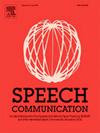Speakers’ communicative intentions lead to acoustic adjustments in native and non-native directed speech
IF 3
3区 计算机科学
Q2 ACOUSTICS
引用次数: 0
Abstract
Speakers adapt acoustic features to factors such as listeners’ linguistic profiles. For instance, addressing a non-native listener elicits Non-Native Directed Speech (NNDS). However, whether these speech adaptations vary depending on the speakers’ didactic goals, in interaction with the listeners' profiles (i.e., native vs. non-native), remains unknown.
We recorded native Spanish speakers naming novel objects to aid their listeners’ performance in comprehension, pronunciation, and writing tasks. Each speaker interacted with a native (Native Directed Speech, NDS) and a non-native (NNDS) Spanish listener. We extracted measures of vowel hyperarticulation, duration, intensity, speech rate, and F0 to assess listener- and task-specific speech adjustments.
Our results showed that speakers hyperarticulated vowels to a greater extent in the writing condition compared to the comprehension condition, and during NNDS compared to NDS. Listener profile and task also impacted speakers’ F0 height, intensity, and vowel duration production. Therefore, speakers adjust acoustic features in their speech to achieve their didactic goals and accommodate their listener's profile. Also, speakers’ overall greater adaptation in NNDS than in NDS suggests that NNDS serves a didactic purpose.
说话者的交际意图导致本族语和非本族语直接语的声学调节
说话者根据听者的语言特征等因素调整声学特征。例如,向非母语听众讲话会引发非母语定向语(NNDS)。然而,这些言语适应是否取决于说话者的教学目标,与听者的个人资料(即母语与非母语)的相互作用,仍然未知。我们记录了以西班牙语为母语的人命名新物体的过程,以帮助他们的听众在理解、发音和写作任务上的表现。每个说话者都与一个西班牙语母语(NDS)和一个非西班牙语母语(NNDS)听众进行互动。我们提取了元音高发音、持续时间、强度、语速和F0的测量来评估听者和任务特定的语音调整。我们的研究结果表明,说话者在写作条件下比在理解条件下高发音,在NNDS过程中比在NDS过程中高发音。听者的形象和任务也会影响说话者的F0高度、强度和元音持续时间的产生。因此,说话者在其讲话中调整声学特征以达到其教学目的,并适应听者的特点。此外,说话者在NNDS中比在NDS中有更大的适应能力,这表明NNDS具有教学目的。
本文章由计算机程序翻译,如有差异,请以英文原文为准。
求助全文
约1分钟内获得全文
求助全文
来源期刊

Speech Communication
工程技术-计算机:跨学科应用
CiteScore
6.80
自引率
6.20%
发文量
94
审稿时长
19.2 weeks
期刊介绍:
Speech Communication is an interdisciplinary journal whose primary objective is to fulfil the need for the rapid dissemination and thorough discussion of basic and applied research results.
The journal''s primary objectives are:
• to present a forum for the advancement of human and human-machine speech communication science;
• to stimulate cross-fertilization between different fields of this domain;
• to contribute towards the rapid and wide diffusion of scientifically sound contributions in this domain.
 求助内容:
求助内容: 应助结果提醒方式:
应助结果提醒方式:


